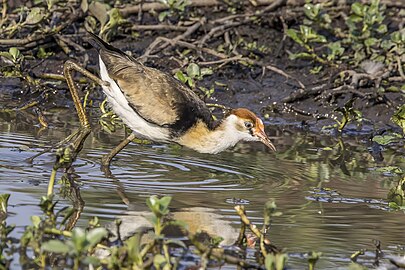The comb-crested jacana (Irediparra gallinacea), also known as the lotusbird or lilytrotter (though these names are sometimes used to describe Jacanidae as a whole), is the only species of jacana in the genus Irediparra. Like other jacana species, it is adapted to the floating vegetation of tropical freshwater wetlands.
| Comb-crested jacana | |
|---|---|
 | |
| Scientific classification | |
| Domain: | Eukaryota |
| Kingdom: | Animalia |
| Phylum: | Chordata |
| Class: | Aves |
| Order: | Charadriiformes |
| Family: | Jacanidae |
| Genus: | Irediparra Mathews, 1911 |
| Species: | I. gallinacea |
| Binomial name | |
| Irediparra gallinacea (Temminck, 1828) | |
Description
This species is unmistakable. It has a black crown and hindneck with a fleshy red wattle covering the forehead and forecrown, contrasting with a white face and throat. The comb is pinker in breeding adults, more orange when not breeding.[2] There is a broad black band on the lower breast with white belly. The underwing and flight feathers, which show most prominently in flight, are black. Back and upperwing mainly grey-brown with black primary coverts, rump and tail. The long legs with extremely long toes trail in flight. The male is slightly smaller than the female and measures 20–22 cm (7.9–8.7 in) in length and weighs 68–84 g (2.4–3.0 oz). The female measures 24–27 cm (9.4–10.6 in) in length and weighs 120–150 g (4.2–5.3 oz).[3] The wingspan ranges from 39 to 46 cm (15 to 18 in).
- Chick
- Juvenile
- Adult
Distribution and habitat
The bird occurs in south-eastern Borneo, the southern Philippines, Sulawesi, Moluccas, Lesser Sunda Islands, north and south-east New Guinea, New Britain (Lake Lalili), and northern and eastern Australia. Its habitat are large freshwater wetlands, swamps and lakes with abundant floating vegetation, such as water-lilies or water hyacinth, forming a mat on the water surface which it is able to walk on. Although the species is rare and localised it is not globally threatened.[2]
Behaviour
General behaviour
The comb-crested jacana walks slowly and deliberately. It often congregates in flocks. When disturbed, it flies low over water and lands again on open vegetation.
Breeding
The comb-crested jacana is polyandrous.[4] It builds a flimsy nest on floating or emergent vegetation, in which the female lays four lustrous, pale brown eggs covered by black markings. Only males incubate.[4] The young hatch well-developed and soon leave the nest.
Feeding
It eats seeds and aquatic insects gleaned from floating vegetation on the water surface.
Voice
This species gives a squeaky, high-pitched chittering, also described as a shrill trill with an explosive soft bugle.[2]
References
Wikiwand in your browser!
Seamless Wikipedia browsing. On steroids.
Every time you click a link to Wikipedia, Wiktionary or Wikiquote in your browser's search results, it will show the modern Wikiwand interface.
Wikiwand extension is a five stars, simple, with minimum permission required to keep your browsing private, safe and transparent.




